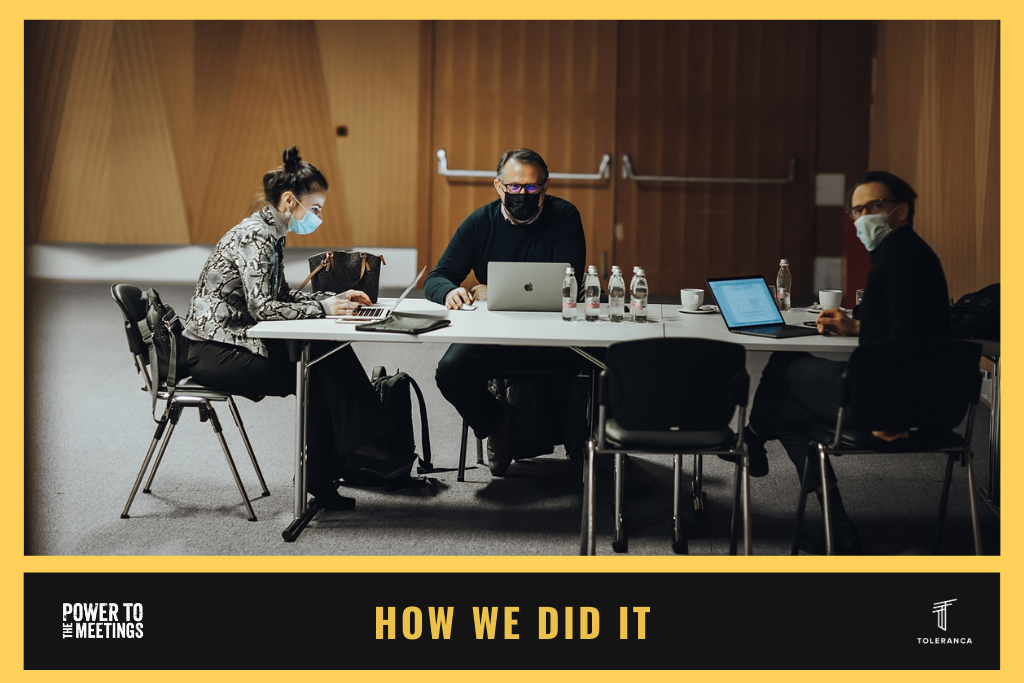
TIPS AND BEST PRACTICES FOR DIGITAL EVENTS
Can you afford to organise an event without context or clear narrative?
You are most likely familiar with the following paradigm. A good film can be filmed based on a good script, yet with a bad script that is virtually impossible. Likewise, digital events cannot be based on a poor scenario. Unfortunately, there are no schools for scriptwriting, and most of the best screenwriters learned the craft themselves. The fundamental prerequisite is to have an idea of what you wish to write about and what kind of message you want to get across. Knowing the topic is the pillar of writing any script.
The corona crisis has shown that the scenario for digital events is truly decisive. In fact, a scenario is the story we want the event to tell. It is manifested in photographs, dialogue, description of acts and the necessary technical details.
Perhaps the most important part is the awareness of what the scenario’s outcome will be. Moreover, the final goal needs to be clearly defined. Much like with film scenarios, you must decide who will be the protagonist and who will play the supporting roles. If the main character represents a brand, then in order to provide a good scenario, the writer must be familiar with the morals and values of the client or brand, as well as with the transformation they wish to achieve with the event.
We will present a step-by-step guide to writing a scenario and showcase the essential parts of writing a good one.
Dramatic event structure
Here, we must draw inspiration from the classic three-act structure. The first act is usually the exposition that includes the inciting incident, whereas in the second act the story includes the confrontation. The final act features the story’s climax, followed by a resolution. In the third act, the spectator usually experiences a catharsis. Such an over-simplified structure can also be used for events. Practice has shown that further plot twists in the form of confrontations and other interactive formats are equally effective.
One page of a scenario equals five minutes of an event
An old Hollywood paradigm is that one page of a scenario equals one minute of film. In events, this rule can be extended to five minutes. It all sounds rational and has been tested in practice; however, it all depends on your focus group. In any case, you should watch your timing when it comes to digital events. It is of the utmost importance, as you cannot redo your event in the same way that you can reshoot a scene in film production. There is no classic “cut” and no second try. Thus, precision is crucial.
A storyboard rocks
If your budget allows it, having a storyboard can be extremely useful when creating events. As the name suggests, it serves as a platform for drawing any scene of an event. It is an excellent tool for thrilling event clients. A picture says more than a thousand words, which also applies for digital events. It will help you to coordinate your project vision with all key stakeholders and create a fabula.
Classic scenario or synopsis
When organising digital events, keep in mind that the scenario needs to include both what is going to happen at the studio and online. I distinguish the so-called synopsis or brief and the actual scenario. The former is a summary of the event’s main ideas, whereas the latter is comprehensive and serves as the final technical disposition of the event. Our recommendation is to write it precisely, as it is often used as the plan for the technical team. It goes without saying that it needs to include precise and professional instructions.
Writing the scenario
Once you start writing, keep in mind that you are telling a story, one that is narrated by the moderator and told through expert lectures, musical equipment, presentations, sound effects and music. The biggest challenge is how to pack everything into a matrix that everyone involved in the project will understand. A good scenario includes all elements, dispersed throughout individual scenes. To illustrate, I often say that one scene is one moderator’s note. There is no prescribed scenario form. Hence, our suggestion is to tailor your matrix to your needs.
Dialogues or monologues
In my opinion, monologues exclude dialogues. Therefore, boring monologues that take the form of introductory speeches should be shortened. Moderators and everyone involved need to be provided with intelligent dialogues that will spice up your event. Although it takes know-how and testing, you will get better and develop your skills with every scenario. Do not overlook the fact that digital events are also a virtual experience. Above all, dialogue writing is among the most creative phases of writing that require the writer to visualise the event.
Test your text at the rehearsal
In my experience, the text needs to be preened at least a few times with both the moderator and others involved. A rehearsal is also a must when it comes to demanding events. Rehearsing will give you a chance to see how the text works in a real situation. Our recommendation is to host the rehearsal a day before the event to give the technicians the opportunity to coordinate and prepare themselves. An interesting dilemma, on the other hand, is whether a rehearsal is needed for smaller, so-called Zoom online events. In our experience, it certainly is, particularly if you are hosting numerous participants.
Do not forget about post-production
No one wants a poorly made video recording of the event. Thus, you need to establish concrete ideas for post-event video montage in your scenario for a digital event. In the digital world, producing video on demand has become a regular practice. It is a part of post-event marketing, which should be considered beforehand. Post-production includes everything from the format to the video’s graphic and sound equipment. In addition, the video needs to be equipped with a suitable “call to action” and should be used as a tool for additional marketing.
Most common mistakes
The most commonly made mistake is event length. As we have emphasised on numerous occasions, the maximum concentration of a participant at a digital event is an hour. In addition, the rule of thumb is that every ten minutes something should occur that is interesting for the audience. There have also been several complications with unclear instructions given to the camera crew regarding the angles, transitions and cuts. Consequently, the video of the event was terrible.
The golden rule when it comes to digital events is to keep it short. Furthermore, the language should be understandable to the focus group. No screenwriter was born a screenwriter, and you will hardly learn the art of writing scenarios from reading books. What does work, though, is hard work, learning and writing.
If you are in a rush, our agency Toleranca Marketing is willing to help, as we have rich experience in writing scenarios.
This article was brought to you by:
Natalija Bah Čad
Toleranca Marketing
Live & Digital Events and Marketing Agency
www.toleranca.eu
For more information, please contact Natalija at natalija@toleranca.eu


